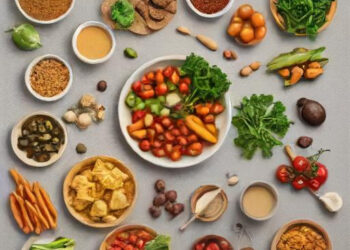By Ayshwaria Prem (cbedit@imaws.org)
India has a wide range of spices and holds a prominent position in the global spices production. Almost all the states and union territories of India grow one or the other spice. A total of 52 spices have been brought under the purview of the Spices Board (by the Ministry of Commerce and Industry) through a Parliamentary Act, and about 109 spices are notified in the ISO list.
The Spices Board is the Indian government regulatory and export promotion agency for Indian spices, headquartered in Kochi. In an exclusive chat, ChefBharath interacted with D. Sathiyan, IFS, who is the Secretary and Chairman of the Spices Board. The in-depth interview helped us understand more about the Indian spices and the work the Spices Board does in promoting and marketing our own products across the world.

CB: Could you please throw some light on the speciality of Indian masalas? How does one judge the quality of spices and what are the regulatory standards?
DS: India has always been known as the land of spices and we produce about 9.8 million tonnes of spices annually, of which exports are 12 per cent and domestic consumption stands at 88 per cent. Curry powders and paste constitute around 4 per cent of the overall spices export.
India has a varied food culture and our cuisines vary vastly even within one state or a given geographical boundary; the food habits and preferences of various communities also differ. So, the Indian masala industry needs to be highly aware of these choices and preferences, and customize its produce to suit the tastes of the end consumers. There is a huge diaspora living outside India. We export around 225 spice items to over 185 global destinations.
There is an increased public awareness about safe and quality food these days. So, the masalas produced should conform to the existing quality standards prescribed by the Food Safety and Standards Authority of India (FSSAI) and other global regulatory authorities. At the same time, it should please the palates of the consumers.
Indian spices are sought after globally for their exquisite aroma, texture, taste and medicinal value. Many of the major spices, such as black pepper and small cardamom, are indigenous to the Indian peninsula and they are superior owing to the special agro-climatic conditions prevailing here. Hence, in addition to the flavour profile and intrinsic quality, emphasis should be on developing perfect blends and quality packaging to keep the flavour intact during storage. The latter part helps in preservation without any contamination, adherence to quality and safety standards, etc.
CB: How do you ensure high quality standards of our spices? How difficult was the process during the Covid-19 pandemic and lockdown?
DS: Indian spices are superior also because of some time-tested traditional methods of production and processing. The Spices Board conducts quality improvement training programmes for the producers every year across India, through our development wing.
We also offer training programmes on good agricultural practices, good manufacturing practices, etc. The board is also promoting quality certifications in the spices sector, aimed at positioning India as a supplier of clean and safe spices. In addition to these, the board has also established Quality Evaluation Laboratories at the major spice trading centres for providing analytical services to the Indian spices industry and monitoring the quality of spices produced and processed in the country.
As a part of our efforts for sustainable production of quality spices for export, a project titled ‘Strengthening the Spice Value Chain in India & Improving the Market Access through Capacity Building and Innovative Interventions’, is being implemented in collaboration with FAO of the United Nations and the Standards and Trade Development Facility (STDF) of WTO. The project targets four major spices: Cumin, Fennel (Gujarat and Rajasthan), Coriander (Maharashtra) and Black Pepper (Andhra Pradesh).
The outbreak of Covid-19 and the associated nationwide lockdown was a period of disruption in the production, processing and transportation fronts. Farming operations were interrupted; there was shortage of labour resources and adequate farm inputs, such as fertilizers and plant protection chemicals, option for post-harvest processing . The sales were minimal and our farmers faced difficulty in safe storage of their produce. At the same time, there was a call for ensuring safe packaging, transportation and delivery, thereby minimizing the chances of viral spread.
The Indian spices industry stood up astonishingly to battle this challenge. The Spices Board extended all possible support to ensure uninterrupted trade of spices. Our offices and Quality Evaluation Laboratories across India were operational to facilitate exports by addressing the issues faced by exporters and other stakeholders. The board ensured timely assistance by creating a help desk and appointing nodal officers to address several concerns and complaints. Standard Operating Procedures (SOPs) were also developed for resuming the activities in the cardamom plantation sector, ensuring social distancing and measures for preventing the disease spread.
CB: What were your biggest challenges during the lockdown?
DS: The Covid -19 pandemic and the subsequent lockdown was a bolt from the blue. When the country went into lockdown, it was the harvesting time for many of the spices and consequently, harvesting, post-harvest processing and storage operations were disrupted. There were hurdles in goods movement as well.
The Covid -19 pandemic, however, increased the public awareness on the quality of food they eat and the need for proper health management. This led to an increased demand from the consumers’ end for ensuring food safety and quality, traceability and sustainability globally.
Our spices were the most sought-after food ingredients during the pandemic period due to their nutraceutical and immunity boosting properties. Comprehending the changing phytosanitary requirements and focusing on public health and safety, we attended Government-to-Government level interactions regularly to streamline the procedures and to promote the export of spices.
Through Indian missions abroad, the board communicated regularly with the foreign governments and regulators to tackle the challenges in the export of spices during Corona. We also supported the Indian farmers and traders to continue their operations seamlessly. The board organized many farmer-trader interactions and buyer-seller meets to ensure that the trade linkages are connected and intact, so that the Indian spices sector could effectively deliver the increased global demand for spices and spice products.
CB: What are the key challenges in encouraging chefs to support smaller spices brands in India?
DS: Food is the Indian way of socializing; getting together with family, relatives and friends. Spices bind the culinary diversity of the nation. From sweet, fragrant cardamom to the world’s spiciest chilli pepper, from smoky cumin to pungent mustard seeds, bold, aromatic spices add character and a rich bouquet to Indian dishes.
Think of spices as musical notes and the rich array of Indian spices makes the Indian cuisine a symphony with a distinct flavour. Chefs are the ambassadors of the Indian gastronomic diversity. Indian cuisine is famous for its spices and complex flavours. It has gained admiration in the international arena because of its subtle and sophisticated cooking methods. The universal popularity of Indian food was initiated from its irresistible flavours and tastes. A balanced combination of taste and nutrition, Indian dishes often get top billing in the list of the world’s best food items. However, the onus is on the Indian chefs to add more to the popularity of Indian cuisines and indigenous dishes.
Post Covid -19 pandemic, there are a lot of opportunities in the spices sector. There is an increased awareness on the goodness of spices, especially about the preventive and curative properties. Spices as ‘functional foods and nutraceuticals’ is a topic very much deliberated with interest across the globe in the wake of this pandemic. Further, the interest and preference for ethnic cuisines and intrinsically rich spices are increasing globally. Traditional and ethnic flavours are becoming more popular across the borders and Indian diaspora is the key. E-commerce platforms provide a lot of scope for promotion of such blends and mixes.
In the present scenario, smaller brands and entrepreneurs have to be well equipped to understand the flavours of various communities and develop signature blends. They have to invest more in identifying, documenting, and protecting the authentic blends and ethnic varieties, and promoting them globally. Further, they should also keep up with the global norms for quality, food safety, traceability and sustainability.
The Spices Board supports the Indian spice industry to expand its potential so as to cater to the increasing global spice demand, adopting to the new normal of doing business. We are also assisting exporters in the R&D of spices, with a view to promote unconventional applications of spices in the health and nutraceutical segment, besides supporting in brand promotions.
CB: What are the key geographical markets in which you are supporting Indian spices manufacturers?
DS: The year 2019-20 was significant when it comes to the export of spices from India. Despite the Covid-19 pandemic, spices export from the country continued its upward trend and crossed the $3 billion mark for the first time in the history of spices export. During 2019-20, there was an export of 11,83,000 tonnes of spices valued Rs 21,515.4 crore ($3033.44 million) as against 11,00,250 tonnes valued Rs 19,505.81 crore ($ 2,805.5 million) during the previous financial year. The same year, 225 Indian spices and spice products reached 185 destinations globally. The leading destinations among them are China, Unites States, Bangladesh, Thailand, United Arab Emirates, Sri Lanka, Malaysia, United Kingdom, Indonesia and Germany. These nine destinations alone contribute more than 70 per cent of the total export earnings from spices during 2019-20.
Indian spices sector recorded an exemplary performance over the past three decades with the total exports of spices and spice products registering an increase of around 17 times from 70,279 MT in 1988 to 11.83 million MT in 2020. About 51 per cent of the spices exported from India are in the form of value-added products, and the high-end value-added items, such as spice oils & oleoresins and mint products, command a share of around 30 per cent of the total exports.
A similar positive outcome has been reflected across other industry indicators, such as export earnings, number & share of value-added products, export destinations, number of registered exporters and processing facilities, etc.
CB: How has the post-pandemic scenario impacted the exports of spices? Please contrast it with that of the pre-pandemic situation.
DS: Covid-19 has been a path-breaker for the whole world, with a mix of disruptive as well as constructive consequences. The Indian spices industry had to embrace a whole lot of changes to adapt itself to the new normal imposed by Covid.
In the changed circumstances, technology really enabled us to transcend the concerns of space and time, thereby adding a different dimension to the notion of proximity. With restrictions on social gathering, many of the interactions, be at the trade front or at inter- governmental regulatory level, were done through virtual platforms.
The Spices Board organized an array of online buyer-seller meets (BSMs) to confirm that the supply chains are not broken at any time during the lock down. These BSMs were found to be effective and economical; and it is felt that the use of these new virtual platforms may continue even after the Covid-19 pandemic concerns.
Due to Covid-19, the emerging new spice world is much equipped with scientific and technology-driven SOPs – right from the farmers’ field extending deeper into the supply chain. Consequent to the pandemic, cultivation practices have been changed with added importance for sanitary and phytosanitary measures, and food safety and quality.
A similar rippling effect was seen at all the levels of processing, packaging, transportation, etc. Novel ways for ease and prompt transport have been resorted to. The spices entrepreneurs in India adapted to the situation by switching over to a new mode of transportation, i.e, by railways, to export spices to neighbouring countries, particularly to Bangladesh, which is not only effective, but a lot cheaper as well.
Post the pandemic, the export fraternity would continue to embrace scientific technologies or methodologies for ensuring food safety and quality with an added importance on the traceability factor. Packaging and transportation segments will also adapt themselves to fit the changing situation. There is a surge in demand for health foods and immunity boosters, which would definitely help the Indian spices sector in reaching further heights.






